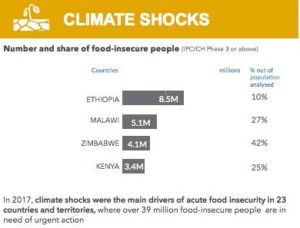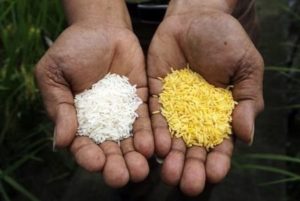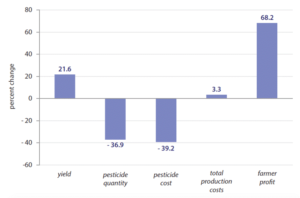Biotechnology and GM Crops Future for Global Food Security
A GMO (Genetically Modified Organism) is an organism whose genetic makeup has been manipulated by humans using biotechnology to insert genes from another organism. Using precision breeding, biotechnologists introduce one or two genes offering useful characteristics—such as nutritional supplementation—to a familiar crop variety.

Figure 1: Due to various misconceptions in the media, many people do not understand what GMOs are and, consequently, believe they are dangerous
While public opinion on genetically modified food is mixed, there is mounting evidence that supports the environmental and health benefits of using biotechnology to produce more nutritional food.
Global Food Insecurity
Currently, the world is suffering from global food insecurity—the lack of affordable and nutritious food. As of 2016, an estimated 815 million people were suffering from chronic undernourishment, and 11 million of these people resided in developed countries (World Hunger). (Retweet this!)
While the term “food insecurity” conjures images of starving children, this isn’t always the case. Food insecurity can also lead to obesity and morbidity, and this is due to a lack of nutrient-rich food.
For instance, more than one-third of Mexico’s population is clinically obese due to food insecurity. Many citizens lack access to fresh, nutritious foods due to low income and must instead buy cheaper, less-nutritious foods that are high in fat and sugar, such as junk food and fast food.

While those in developing countries suffer from food insecurity, especially those who live in food deserts (a geographic area in which access to healthy, fresh foods is limited or nonexistent), those residing in lower-middle-income countries especially suffer from micro-nutrient deficiencies in:
- Iron: Deficiencies in iron can lead to iron-deficiency anemia, poor pregnancy outcomes, impaired physical and cognitive development, increased risk of morbidity in children, and reduced work productivity in adults (World Hunger)
- Iodine: An estimated 38 million babies are born with iodine deficiency, which is one of the main causes of impaired cognitive development in children. While iodine deficiency has decreased rapidly since the introduction of iodized salt, 54 countries still suffer from a lack of this micro-nutrient, especially in areas of Africa and Asia
- Vitamin A: Vitamin A deficiency causes blindness, impairs growth in children, and reduces the body’s resistance to disease. According to the 2018 World Hunger and Poverty Statistics, an estimated 250 million preschool children are vitamin A deficient—and 250,000-500,000 of these children go blind every year, 50 percent of them dying within 12 months of losing their sight.
Two major causes of global food insecurity include poor food and agricultural policy and climate change.
A lack of productive agricultural technologies in lower-middle-income countries has led to lower crop production as compared to that of upper income countries. Additionally, land and soil degradation caused by unsustainable agricultural practices has consumed and polluted available ground water and depleted the natural resources of these lower-middle-income countries.
Unstable weather patterns due to climate change have also negatively impacted agricultural land in lower-to-middle income countries. For example, in 2016, El Niño caused severe food insecurity for 20 million people (World Hunger).

Figure 3: Courtesy of FAO, WFP, & EU, 2018
One way that biotechnologists can help reduce the amount of micro-nutrient deficiencies in developing countries is with the use of GMOs.
Golden Rice Debate
The Golden Rice Project, introduced in 1999 by professors Ingo Potrykus and Peter Beyer, proposed the genetic modification of rice in order to increase its nutrient level and combat Vitamin A Deficiency (VAD) in developing countries, whose diets rely heavily on rice and other micro-nutrient-poor carbohydrates.
Yet organizations, such as Friends of the Earth and Greenpeace, opposed The Golden Rice Project, arguing that golden rice would not solve the VAD epidemic in developing countries. Friends of the Earth pointed to cheaper alternatives for reducing VAD, such as UNICEF’s Vitamin A Supplementation Program, which improves a child’s survival rate by 12-24 percent and costs merely a few cents. In addition, they argued that golden rice provides only 10 percent of the daily requirement for vitamin A.
In a 2009 clinical trial published in the American Journal of Clinical Nutrition, however, results demonstrated that one cup of golden rice supplies 50 percent of the Recommended Dietary Allowance of vitamin A.

Figure 4: Genetically modified golden rice could help combat VAD epidemic in developing countries
Additionally, The Golden Rice Project would make an impact on the VAD epidemic by complementing existing VAD solutions. And unlike existing programs, which consume millions of dollars per country annually, The Golden Rice Project exists as a sustainable and cheaper program, supplying free technology transfer to support developing countries.
The debate continued until June of 2016, when 110 Laureates signed a letter in support of GMOs, urging Greenpeace and other organizations to cease campaigning against The Golden Rice Project and GMOs. In the letter, they state:
Scientific and regulatory agencies around the world have repeatedly and consistently found crops and foods improved through biotechnology to be as safe as, if not safer than those derived from any other method of production. There has never been a single confirmed case of a negative health outcome for humans or animals from their consumption. Their environmental impacts have been shown repeatedly to be less damaging to the environment, and a boon to global biodiversity. (To the Leaders of Greenpeace, the United Nations, and Governments around the world)
But opposing organizations are not the only ones to blame for the sluggish introduction of golden rice. The Golden Rice Project is years away from being introduced to developing countries due to a lack of research on golden rice’s health and environmental effects.
Advantages of using GM Crops
Not only are GM crops more nutritious, but they are also more environmentally friendly than conventional crops and agricultural practices.
According to a meta-analysis on the impact of GMOs on biodiversity, “GM crops may actually increase crop diversity by enhancing underutilized alternative crops, making them more suitable for widespread domestication” (Capritto). Growing GM crops results in a higher productivity on cultivated lands as opposed to non-productive agricultural practices that consume more land and destroy biodiversity. (For more on this, visit out article on Regenerative Agriculture.)
In addition to the support of biodiversity, GM farming reduces pesticide use by 37 percent and increases crop yields by 22 percent.
Below are numerous examples that demonstrate the positive effects of GM crops (to read the case studies in depth, click here):
- Virus-Resistant Papaya
- Non-Browning Apples
- Insect-Resistant Brinjal, Talong, Aubergine, and Eggplant
- Herbicide-Tolerant Crops
- Insect-Resistant Cotton
- Insect-Resistant Corn
- Drought-Resistant Corn
- Sustainable Potatoes
To combat food insecurity, biotechnologists are looking to genetically modify crops in order to increase crop yield and resist pests, microbial infections, drought, and herbicides.
According to a review of 150 studies, the benefits of planting GM crops include:
- 22 percent yield increase in GM soybeans, maize, and cotton
- 37 percent decrease in pesticide use
- 68 percent increase in farmer profits
- 14 percent higher yield gains for farmers in developing countries
- 60 percent higher profit gains for farmers in developing countries

Figure 5: GMOs demonstrate economic and environmental benefits. Photo courtesy of Christopher Gerry and Kristen Seim, Harvard University
With increasing yield and profit gains for farmers in developing countries, food insecurity in these regions could dramatically decrease.
xVirity’s Role in GM Crops
The bottom line is that biotechnologists genetically modify crops in order to promote plant growth—and xVirity shares this goal.
Our liquid fertilizer, xVital, combines nitrogen with ionized water to support sustainable, environmentally-friendly plant growth. xVital complements regenerative and sustainable agricultural practices by offering an alternative to conventional fertilizers, whose high salt concentrations lead to soil acidification.
While GM crops are more resistant to pests, microbial infections, and herbicides, they aren’t guaranteed virtual resistance from such issues. xVital serves as an excellent complement to GM crops, as it prevents and treats root rot, replenishes plant growth and color due to nitrogen deficiency, and supports seed germination and root propagation.
There is never one solution to a problem. To combat global food insecurity, we must design and implement a variety of solutions that complement one another for the most effective outcome. To support the growth and resiliency of your crops or plants, turn to xVital today.
Sources:
Genetically Modified Organisms: the “Golden Rice” Debate
Laureates Letter Supporting Precision Agriculture (GMOs)
2018 World Hunger and Poverty Facts and Statistics
Feeding the World one Genetically Modified Tomato at a Time: A Scientific Perspective



